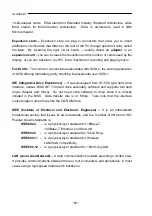
GLOSSARY
~ 55 ~
SCSI (Small Computer System Interface) –
An intelligent bus for transmitting data
commands between a variety of devices. There are many implementations of SCSI,
including Fast SCSI, Wide SCSI, Fast Wide SCSI, Fast-20, and Fast-40.
SCSI-2 –
The second generation of SCSI; includes many improvements to SCSI-1,
including Fast SCSI, Wide SCSI, and mandatory parity checking.
SCSI-3 –
The third generation of SCSI; introduces Fast-20 and Fast-40 as
improvements to the parallel bus. The standard also includes a number of
specifications for high-speed serial bus architectures such as SSA, Fiber Channel, and
IEEE 1394. Also known as Ultra SCSI.
Ultra SCSI –
Also known as SCSI-3, is a third generation SCSI standard that introduced
parallel bus speed improvements (FAST-20 and FAST-40), an the miniaturized 68-pin
micro connector.
USB (Universal Serial Bus) –
USB consolidates serial, parallel, keyboard, mouse, and
game ports into one asynchronous and isochronous communications port with
bandwidth for data transfer speeds up to 12 Mbps without termination. By
daisy-chaining USB hubs, up to 127 I/O devices can be connected to one USB port on
the PC. USB is completely plug-and play meaning peripherals can be correctly
detected and configured automatically as soon as they are connected.
UTP (Unshielded Twisted Pair) –
Twisted pair cable with neither individual nor overall
shielding.
Twisted Pair
are two wires twisted together to reduce susceptibility to RF
crosswalk.
VGA (Video Graphics Array) –
A video adapter that supports 640x480 pixels color
resolution. The Windows OS provides medium text & graphics standard.
VL-Bus –
It is also known as Local Bus; this is an I/O interface that is directly connected
to and dependant on the system CPU. The VL-Bus is an abbreviation of VESA Local
Bus.




















